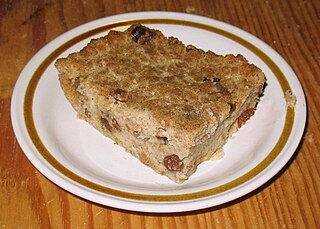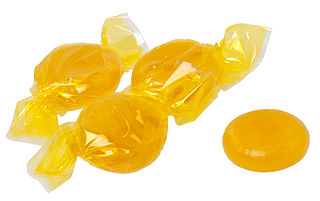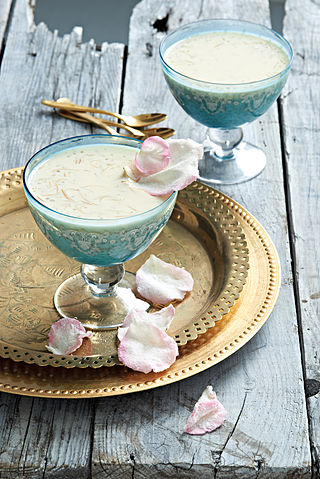
Dessert is a course that concludes a meal. The course consists of sweet foods, such as confections, and possibly a beverage such as dessert wine and liqueur. In some parts of the world, such as much of Greece and West Africa, and most parts of China, there is no tradition of a dessert course to conclude a meal.

Bread pudding is a bread-based dessert popular in many countries' cuisines. It is made with stale bread and milk or cream, generally containing eggs, a form of fat such as oil, butter or suet and, depending on whether the pudding is sweet or savory, a variety of other ingredients. Sweet bread puddings may use sugar, syrup, honey, dried fruit, nuts, as well as spices such as cinnamon, nutmeg, mace, or vanilla. The bread is soaked in the liquids, mixed with the other ingredients, and baked.

Trifle is a layered dessert of English origin. The usual ingredients are a thin layer of sponge fingers or sponge cake soaked in sherry or another fortified wine, a fruit element, custard and whipped cream layered in that order in a glass dish. The contents of a trifle are highly variable and many varieties exist, some forgoing fruit entirely and instead using other ingredients, such as chocolate, coffee or vanilla. The fruit and sponge layers may be suspended in fruit-flavoured jelly, and these ingredients are usually arranged to produce three or four layers. The assembled dessert can be topped with whipped cream or, more traditionally, syllabub.

Marshmallow is a type of confectionery that is typically made from sugar, water and gelatin whipped to a solid-but-soft consistency. It is used as a filling in baking or normally molded into shapes and coated with corn starch. The sugar confection is inspired by a historical medicinal confection made from Althaea officinalis, the marsh-mallow plant.

Christmas pudding is sweet dried-fruit pudding traditionally served as part of Christmas dinner in Britain and other countries to which the tradition has been exported. It has its origins in medieval England, with early recipes making use of dried fruit, suet, breadcrumbs, flour, eggs and spice, along with liquid such as milk or fortified wine. Later, recipes became more elaborate. In 1845, cookery writer Eliza Acton wrote the first recipe for a dish actually called "Christmas pudding".

Cheesecake is a sweet dessert consisting of one or more layers. The main, and thickest, layer consists of a mixture of a soft, fresh cheese, eggs, and sugar. If there is a bottom layer, it most often consists of a crust or base made from crushed cookies, graham crackers, pastry, or sometimes sponge cake. Cheesecake may be baked or unbaked.

Butterscotch is a type of confectionery whose primary ingredients are brown sugar and butter. Some recipes include corn syrup, cream, vanilla, and salt. The earliest known recipes, in mid-19th century Yorkshire, used treacle (molasses) in place of, or in addition to, sugar.

Rice pudding is a dish made from rice mixed with water or milk and other ingredients such as cinnamon, vanilla and raisins.

South African cuisine reflects the diverse range of culinary traditions embodied by the various communities that inhabit the country. Among the indigenous peoples of South Africa, the Khoisan foraged over 300 species of edible food plants, such as the rooibos shrub legume, whose culinary value continues to exert a salient influence on South African cuisine. Subsequent encounters with Bantu pastoralists facilitated the emergence of cultivated crops and domestic cattle, which supplemented traditional Khoisan techniques of meat preservation. In addition, Bantu-speaking communities forged an extensive repertoire of culinary ingredients and dishes, many of which are still consumed today in traditional settlements and urban entrepôts alike.

Ugali or posho or sima is a type of corn meal made from maize or corn flour in several countries in Africa. Sima is sometimes made from other flours, such as millet or sorghum flour, and is sometimes mixed with cassava flour. It is cooked in boiling water or milk until it reaches a stiff or firm dough-like consistency. In 2017, the dish was added to the UNESCO Representative List of the Intangible Cultural Heritage of Humanity, one of a few foods in the list.

Persimmon pudding is a dessert pudding made with persimmons. There is a lot of variety in the recipes, some are made with eggs, others add sweet potatoes or pumpkin. There's no set recipe, although common ingredients include some type of cornmeal or flour, brown sugar or molasses, and spices like cinnamon, nutmeg and ginger. Owing to the difficulty of preparing the pulp from wild American persimmons, persimmon pudding is mostly a regional specialty of the Cuisine of the Midwestern United States.

Jello salad is an American salad made with flavored gelatin, fruit, and sometimes grated carrots or other vegetables. Other ingredients may include cottage cheese, cream cheese, marshmallows, nuts, or pretzels. Jello salads were popular in the 1960s and are now considered retro.

Bobotie is a well-known South African dish consisting of spiced minced meat baked with an egg-based topping.

Cabinet pudding, also known as chancellor's pudding or Newcastle pudding, is a traditional English steamed, sweet, moulded pudding made from some combination of bread or sponge cake or similar ingredients in custard, cooked in a mould faced with decorative fruit pieces such as cherries or raisins, served with some form of sweet sauce. Other versions of cabinet pudding might use gelatin and whipped cream.

Malva parviflora is an annual or perennial herb that is native to Northern Africa, Europe and Asia and is widely naturalised elsewhere. Common names include cheeseweed, cheeseweed mallow, Egyptian mallow, least mallow, little mallow, mallow, marshmallow, small-flowered mallow, small-flowered marshmallow and smallflower mallow. M. parviflora leaf extracts possess anti-inflammatory and antioxidant activities. It has a decumbent or erect habit, growing up to 50 cm in height. The broad leaves have 5 to 7 lobes and are 8 to 10 cm in diameter. It has small white or pink flowers with 4 to 6 mm long petals.

Sponge cake is a light cake made with egg whites, flour and sugar, sometimes leavened with baking powder. Some sponge cakes do not contain egg yolks, like angel food cake, but most of them do. Sponge cakes, leavened with beaten eggs, originated during the Renaissance, possibly in Spain. The sponge cake is thought to be one of the first of the non-yeasted cakes, and the earliest attested sponge cake recipe in English is found in a book by the English poet Gervase Markham, The English Huswife, Containing the Inward and Outward Virtues Which Ought to Be in a Complete Woman (1615). Still, the cake was much more like a cracker: thin and crispy. Sponge cakes became the cake recognized today when bakers started using beaten eggs as a rising agent in the mid-18th century. The Victorian creation of baking powder by English food manufacturer Alfred Bird in 1843 allowed the addition of butter to the traditional sponge recipe, resulting in the creation of the Victoria sponge. Cakes are available in millions of flavours and have many recipes as well. Sponge cakes have become snack cakes via the Twinkie.

Boeber is the Cape Malay name for a South African pudding. It has become a traditional Cape Malay sweet, milk drink, made with vermicelli, sago, sugar, and flavoured with cardamom, stick cinnamon, and rose water. The pudding is traditionally served on the 15th night of Ramadan to celebrate the middle of the fast, for those who have completed the first 15 days of fasting. They are also known as people who are op die berg.
Blatjang is a South African chutney made of dried fruit and chillies cooked in vinegar and a staple in most white South African households, served as a condiment with South African meat dishes like bobotie and braai.

















